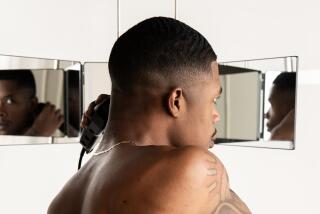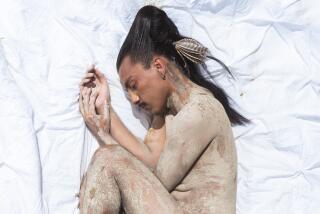Vidal Sassoon had a style of his own
When most people think of Vidal Sassoon, who died Wednesday at age 84, they think Carnaby Street. But he also had a role in shaping Los Angeles as a city of style.
“He opened a salon on Rodeo Drive when Beverly Hills was just coming of age among trendsetters,” says Rose Apodaca, author and former Los Angeles bureau chief of Women’s Wear Daily. “And he saw Los Angeles as this exciting place where rules were being broken. We know about swinging London; he saw Los Angeles as an extension of that.”
The British-born hairstylist created wash-and-go hair in the early 1960s. He liberated women from having to wear curlers to bed and make weekly trips to the salon by creating modern, geometric cuts that fell into place without a lot of fuss. It was the equivalent to what fashion designer Mary Quant was doing with miniskirts in London and what Rudi Gernreich was doing with unstructured knitwear in L.A. They were all using fashion and beauty as instruments for social change.
“His scissors cut away the weight of an era, exposed necks, rid us of rollers — until roller-set waves returned recently — and made every girl want to get a pair of go-go boots and miniskirt,” said Anne Crawford, a fashion publicist and former editor at the late L.A. Style magazine.
Sassoon opened salons in London in 1954, New York in 1965 and Los Angeles in 1970.
He was drawn to the avant garde fashion and art scene in 1960s and ‘70s L.A. that revolved around designer Gernreich and model-muse Peggy Moffitt, who has worn Sassoon’s famous “five-point” haircut since 1965.
Moffitt remembers first seeing Sassoon’s name in Glamour magazine in an article about wash-and-wear hair. “I was enthralled by the idea, and thought it was wonderful not to be going to sleep with sewer pipes stuck on your scalp, bleeding onto your pillow every night.’”
She first met the hairstylist on a photo shoot at Richard Avedon’s studio in New York in 1965 and reconnected with him later that year in Los Angeles, when he was out visiting his friend and fellow hairstylist, Gene Shacove.
“Vidal did a demonstration for all the hairdressers in the evening, and he cut my hair then,” Moffitt said. “We were on a little tiny riser so people could see, and Vidal got so into it, he fell off the riser. He was very intense when he was working.”
Afterward, they went out for hamburgers. “Vidal kept a little pair of scissors in his pocket, and while I was eating, he’d look over and snip off a little more.”
During that same trip, she introduced Sassoon to Gernreich, and the two men became fast friends. “I can remember showing him Rudi’s sketches and explaining how he and Rudi were doing something very similar by thinking architecturally and not out of the same old box.”
Shortly afterward, Moffitt moved to London, where she became a house model for Sassoon. She remembers the salon being a magnet for celebrities, even ones she wouldn’t associate with Sassoon’s style, like Ingrid Bergman, whom she spotted on her first day.
Sassoon raised the stakes for celebrity hair styles when Roman Polanski (also a client) paid him $5,000 to give Mia Farrow her famous pixie cut in 1968 for the film “Rosemary’s Baby.”
Sassoon moved to L.A. in the 1970s, part of a wave of British tastemakers who included artist David Hockney and restaurateur Michael Chow, whose former wife Grace Coddington, now the creative director of Vogue magazine, first modeled the five-point cut in the 1960s.
“We were all products of the same cultural revolution in London in the ‘60s,” Chow said.
Sassoon was known for his debonair style, Pilates-toned body and good manners. He sold his business in the 1980s, and as his fortune grew, became a philanthropist here and beyond, a modern architecture enthusiast and art collector. (Frank Gehry and Ed Ruscha were favorites, and he owned multimillion dollar Neutra- and Hal Levitt-designed homes.)
“He was always beautifully dressed, favored scarves and slim-cut clothing and had beautiful wives,” Crawford said. (Sassoon was married four times, leaving behind his wife of 20 years, Ronnie.)
He was also an early proponent of fitness, exporting his ideas about a healthy lifestyle in the 1975 book “A Year of Beauty and Health,” co-written with then-wife Beverly Sassoon. In 1984, Vidal Sassoon was named the “official hairstylist” of the Summer Games in Los Angeles, creating hairstyles inspired by Olympic sports.
“Whenever Vidal would walk into a room, everyone subconsciously smoothed their hair,” Crawford said. “He was always on, smiling, kissing his way through the crowd.”
He established the concept of hairstyling as a brand, launching a global empire with training academies, product lines and TV commercials preaching the gospel, “If you don’t look good, we don’t look good.”
But in many ways, Sassoon worked more like a fashion designer than a hairstylist. He debuted new hairstyles each season, just as designers debut new fashion collections.
“Rather than having stylists with different points of view, he had all of his people trained at his schools,” Moffitt said. “There was a technique, a signature way of handling hair.”
“The foundation of what he did, using geometry to determine face shape and accentuate a woman’s bone structure, it was revolutionary,” said Etienne Taenaka, manager of the Beverly Hills salon, now located on Little Santa Monica Boulevard.
Apodaca started getting her hair cut at the salon after she was hired at WWD in 2000, even though Sassoon had long since put down his scissors. Often, she would sit next to Moffitt while having her hair done.
“I would spend two to six hours there between my exacting hair cut and [dyed] blue streak,” Apodaca said. “There was this sense of continuing community, of being part of the Vidal culture. You always knew the name was equated with something edgy, cool and futuristic.”







